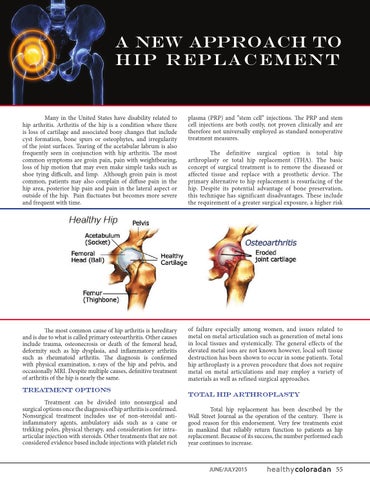A New Approach to Hip Replacement
Many in the United States have disability related to hip arthritis. Arthritis of the hip is a condition where there is loss of cartilage and associated bony changes that include cyst formation, bone spurs or osteophytes, and irregularity of the joint surfaces. Tearing of the acetabular labrum is also frequently seen in conjunction with hip arthritis. The most common symptoms are groin pain, pain with weightbearing, loss of hip motion that may even make simple tasks such as shoe tying difficult, and limp. Although groin pain is most common, patients may also complain of diffuse pain in the hip area, posterior hip pain and pain in the lateral aspect or outside of the hip. Pain fluctuates but becomes more severe and frequent with time.
plasma (PRP) and “stem cell� injections. The PRP and stem cell injections are both costly, not proven clinically and are therefore not universally employed as standard nonoperative treatment measures.
The most common cause of hip arthritis is hereditary and is due to what is called primary osteoarthritis. Other causes include trauma, osteonecrosis or death of the femoral head, deformity such as hip dysplasia, and inflammatory arthritis such as rheumatoid arthritis. The diagnosis is confirmed with physical examination, x-rays of the hip and pelvis, and occasionally MRI. Despite multiple causes, definitive treatment of arthritis of the hip is nearly the same.
of failure especially among women, and issues related to metal on metal articulation such as generation of metal ions in local tissues and systemically. The general effects of the elevated metal ions are not known however, local soft tissue destruction has been shown to occur in some patients. Total hip arthroplasty is a proven procedure that does not require metal on metal articulations and may employ a variety of materials as well as refined surgical approaches.
Treatment Options Treatment can be divided into nonsurgical and surgical options once the diagnosis of hip arthritis is confirmed. Nonsurgical treatment includes use of non-steroidal antiinflammatory agents, ambulatory aids such as a cane or trekking poles, physical therapy, and consideration for intraarticular injection with steroids. Other treatments that are not considered evidence based include injections with platelet rich
The definitive surgical option is total hip arthroplasty or total hip replacement (THA). The basic concept of surgical treatment is to remove the diseased or affected tissue and replace with a prosthetic device. The primary alternative to hip replacement is resurfacing of the hip. Despite its potential advantage of bone preservation, this technique has significant disadvantages. These include the requirement of a greater surgical exposure, a higher risk
Total Hip Arthroplasty Total hip replacement has been described by the Wall Street Journal as the operation of the century. There is good reason for this endorsement. Very few treatments exist in mankind that reliably return function to patients as hip replacement. Because of its success, the number performed each year continues to increase.
JUNE/JULY2015
55
